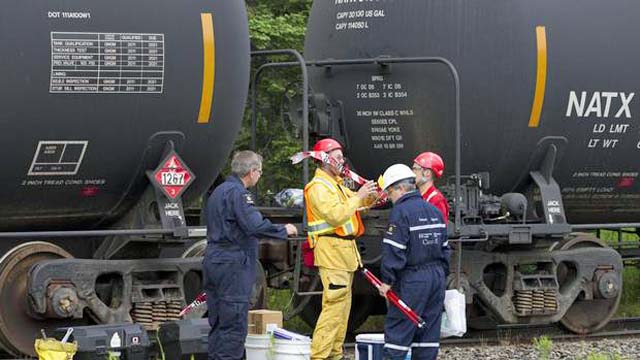
Ottawa Ontario - Nearly three years after the Lake Megantic rail disaster, new information shows the tragic explosion that killed 47 people could have been avoided by a simple 10-second safety procedure that Transport Canada (TC) did not require the cost-cutting railway to use.
The revelation comes after the federal regulator issued revamped rail operating rules late last year, aimed at preventing another tragedy like the one that gutted the Quebec town in July, 2013, when a parked train loaded with highly volatile crude oil rolled down a hill and exploded, killing dozens of people instantly and decimating the downtown.
In the new operating rules, TC requires that all trains left unattended, as the Lake Megantic train was on the night of the explosion, must be secured by a minimum number of hand brakes, which are brakes the crew sets manually on each rail car to hold it in place.
The new rules also call for a backup method to be used for securing the train, and suggests the train's air brakes are one of the secondary defences that should be used.
Contained in that suggestion is a nuance that has gone largely unnoticed until now, and has been glossed over in the official report into the Lake Megantic disaster.
In addition to hand brakes, trains are equipped with two air-brake systems, the independent brake, which secures the locomotives, and the automatic brake, which holds the rail cars in place.
The Transportation Safety Board's (TSB) investigation into the derailment states that the failure of the locomotive air brake (the independent brake) on the night of the disaster was a key factor that led to the tragedy.
However, on page 105 of the 179-page report, a single paragraph suggests the accident "likely" would have been avoided had the air brakes on the rail cars (the automatic brake) been set as a backup safety precaution before the train was left unattended.
However, Montreal Maine & Atlantic Railway (MMA) instructed its staff not to use the automatic brakes.
TC either didn't notice this practice or saw no problem with it.
"While MMA instructions did not allow the automatic brakes to be set following a proper hand brake effectiveness test, doing so would have acted as a temporary secondary defence, one that likely would have kept the train secured, even after the eventual release of the independent brakes," the TSB said in its report.
Setting the automatic brake takes only about 10 seconds, yet it would have been enough of a backup measure to hold the train in place long enough to prevent the disaster, and probably much longer, said one railway industry expert who spoke to The Globe and Mail.
The expert, who is familiar with braking systems on trains, spoke on condition of anonymity because the person is employed in the sector.
In order to set the brake, the locomotive engineer simply needs to move a lever in the cab from left to right, and in seconds the brake shoes are applied against the wheel of each rail car.
However, because air needs to be pumped back into the brake line in order to reset the system and get the automatic brakes on each car to release, it can sometimes take from 15 minutes to an hour to get a train moving again once it's been parked.
For this reason, some railways don't like using the automatic air brakes as an added assurance or backup to the hand brakes, because it can cost time and money, the rail industry expert said.
The TSB determined that on the night of the explosion, the engineer didn't set enough hand brakes on each car to keep the train from rolling down a hill into Lake Megantic, where it derailed.
While that fact is not in dispute, it is not clear why MMA was allowed to order its employees not to use the automatic brakes as a backup.
Asked why the railway was able to issue such an instruction to its staff, TC told The Globe that its role is "to monitor railway companies for compliance with rules, regulations, and standards through audits and safety inspections."
However, the department added, "TC does not approve or enforce company instructions."
Automatic brakes are by no means considered fail-safe, though they can be helpful.
Edward Burkhardt, the chairman of MMA at the time of the disaster, said the brakes on rail cars also rely on air pressure within the brake cylinder to hold the train still.
Over time, the air pressure in some of the brake cylinders can leak off and the automatic brakes will not work.
How long it takes for that to happen, though, depends on a variety of factors, including how many cars the train is carrying.
The more cars, the longer it takes for the automatic brake to stop working.
"It's temporary. How long is temporary? That's subjective," Mr. Burkhardt said in an interview.
"It could have been sufficient to hold the train there all night until the relief crew came on, in which case we would have had no such incident at Lake Megantic. But it might not have been, too. It might have meant that the accident occurred a few hours later than it did."
However, the rail industry expert interviewed by The Globe said a train the length of the one that exploded in Lake Megantic, which was carrying upwards of 70 cars, would have been held in place for at least a day, or significantly longer, because most of the rail cars' brakes would not have released in that time, and there were seven hand brakes also holding the train in place.
It is far-fetched to think the automatic brake wouldn't have played a direct role in preventing the accident, the person said.
"This common sense, 10-second procedure has been used to secure rail cars for the last hundred years," the rail industry source said.
The automatic brake is now considered an acceptable backup to hand brakes in the new operating rules issued in October.
However, it is not clear why stricter rules requiring such backup measures weren't in place the night of the Lake Megantic disaster.
The tragedy exposed how lax Canada's rail regulations were, with railways often permitted to write their own procedures that were not sufficiently audited by TC inspectors.
In its report, the TSB cited "inadequate oversight" of railway operations as one of several contributing factors in the crash.
However, asked why a simple safety procedure that could have prevented the disaster was buried deep in the report, and limited to a single paragraph, the TSB said it didn't want to distract from the main point that trains should be secured with the correct number of hand brakes.
"We tried to steer away from any suggestion that air alone is sufficient to hold a train and instead to focus on more permanent solutions to train securement," said John Cottreau, spokesman for the TSB.
"The TSB recognizes that an air brake application would have likely ensured that the train would have remained secured until the next morning, but it was not guaranteed."
The TSB pointed to a derailment in 2011 in which a train operated by a regional railway rolled away while being held by an automatic brake.
But in that case, the train consisted of older, malfunctioning cars, with a unique design that weren't properly tested, making the situation difficult to compare.
The TSB also says in its report that Canadian National Railway often uses the automatic brake as a standard backup method of securing its trains.
TC also said hand brakes are the priority, but did not say why MMA was allowed to ignore the automatic brake, even though it was flagged by the TSB as something that likely could have saved the town.
"Hand brakes are the first line of defence in preventing equipment from rolling away," TC spokeswoman Melany Gauvin said.
MMA, which declared bankruptcy after the derailment, had a reputation as one of the most aggressive cost-cutters in the rail industry, and had received unusual exemptions from TC, such as operating with a one-man crew, which allowed it to save money on labour.
The revelation that shows MMA train operators were instructed not to use the backup air brake, even though it could have likely prevented the accident, comes at a time when the town is still suffering as it tries to recover from the disaster.
A recent study released by public-health authorities indicates two-thirds of residents still suffer from "moderate to severe" post-traumatic stress from the deadly fires that destroyed the downtown, and some are now traumatized by daily events such as sunsets, slamming doors, and the sight of trains.
The accident has cost the federal government more than $155 million so far in funds that are being distributed to help the community rebuild.
Grant Robertson.


